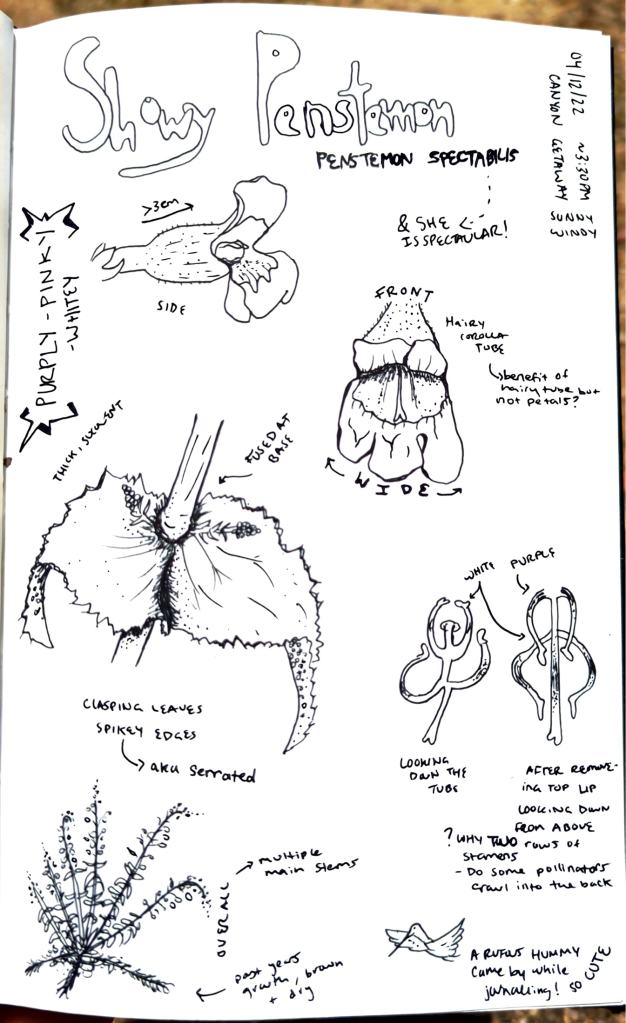I had a mad craving for some nature journaling last week. So I took to our current “backyard” in the outskirts of Ramona in a small community called Fernbrook which is in the county of San Diego, California.
Nature journaling is a super-duper way to connect with nature, at the landscape or macroscopic level. Journaling could be a one-time thang, or a series of entries on one topic, in one location, or as seasons change. The beauty of nature journaling there are endless possibilities, and you are never too old. What I like to do is draw the subject, usually breaking down some of the elements, and then start pondering its evolution and these three questions:
- I notice. . .
- I wonder. . .
- It reminds me of. . .
These are, from my experience the most common nature journalling prompts. Give them a try yourself while in nature, or looking out your window.
So as you scroll through this post, you’ll find the name of the plant, photos of said plant, my nature journal of said plant, and a little blurb of context.
Monday: Chaparral Yucca



Chapparal Yucca, aka shin-stabbing statan plant. . . when it’s not flowering. . . but also when it’s flowering. The long thin leaves at the base of the flowering stalk protect the inner juicy heart. Only when the plant reaches maturity does it send up a stalk topped with a plethora of flowers on a branched panicle. Sadly after flowering, fruiting, and supporting the California Yucca Moth and their symbiotic relationship the plant dies. For a perennial plant, this one goes out with quite the show. Super cool, super neat, super spikey.
Tuesday: Showy Penstemon





Ooooof these bad boys take the cake for the most brilliant bloomers, and continue to do so as I write this post a week or so after journaling them. Who is she? Showy Penstemon, is absolutely a showstopper, as these macro photos show. The latin name is Penstemon spectabilis, which I’m sure you’ll agree is quite accurate.
Wednesday: Parish’s Nightshade



These purple plants, the Parish’s Nightshade assert their dominance in many sections in the small valley our Airbnb resides. I’ve been amazed how they just seem to keep sprouting up! We’ve seen these plants before in Northern California, as they do range as north as Oregon. But the ones around here are, like a few other plants this spring just keep on popping up! I figured they would have finished blooming weeks ago. Incredible!
Caterpillar Scorpionweed




This one I just focused on drawing, less scribbling of notes and ponderings. Moreso I focused on trying to capture the curl of the inflorescence, as you can see in the bottom portion of the page. I also may or may not have run out of time and had to go on our evening walk. . . . But I had planned to return to the page after the weekend, but sadly as a part of the wildfire management (so I assume) most of the plants had been brush-cut to oblivion. RIP.
Parry’s Phaelia




I don’t have a photo of the journal entry next to the exact flower because I was getting burned alive in the mid-day sun. When I went back the next day, all the petals had fallen off! BAH! As you can see in the photo the petals were a bit crusty, so the flower photos are also from other observations.

Parry’s Phacelia is a fire follower on recently burned slopes. We love a fire-follower, but the thing that really gets me every time is the color of their petals. Turning the corner on a trail and having a few of these staring back at you is just simply STRIKING!
Craving a little more?
If you want to learn more about nature journaling, I wrote a doc that’s a part of the Mission Blue Butterfly Module I created for the Pacific Beach Coalition, an environmental non-profit based in the SF Bay Area. If you are a teacher, homeschool teacher, or educator in any capacity, this is the doc for you for Earth Day, Earth Month, or anytime throughout the year!
A few Resources
- I’m sure there are many more great links on this topic, but here’s a few:
- John Muir Laws aka California based King of Nature Journaling
- List of Nature Journal Instructors based on location (worldwide)
- Marley Peifer
- Sketching for Observation, California Academy of Sciences
- John Muir Laws aka California based King of Nature Journaling
Here are closeups of each entry and the informational pages I wrote after coming back inside.







Great backyard flowers and drawings of them!! The nightshade plant looks so much like a potato plant. I believe they are related.
LikeLike
Thank you! Yes indeed they are! They are both in the Genus Solanum. Cousins!
LikeLike